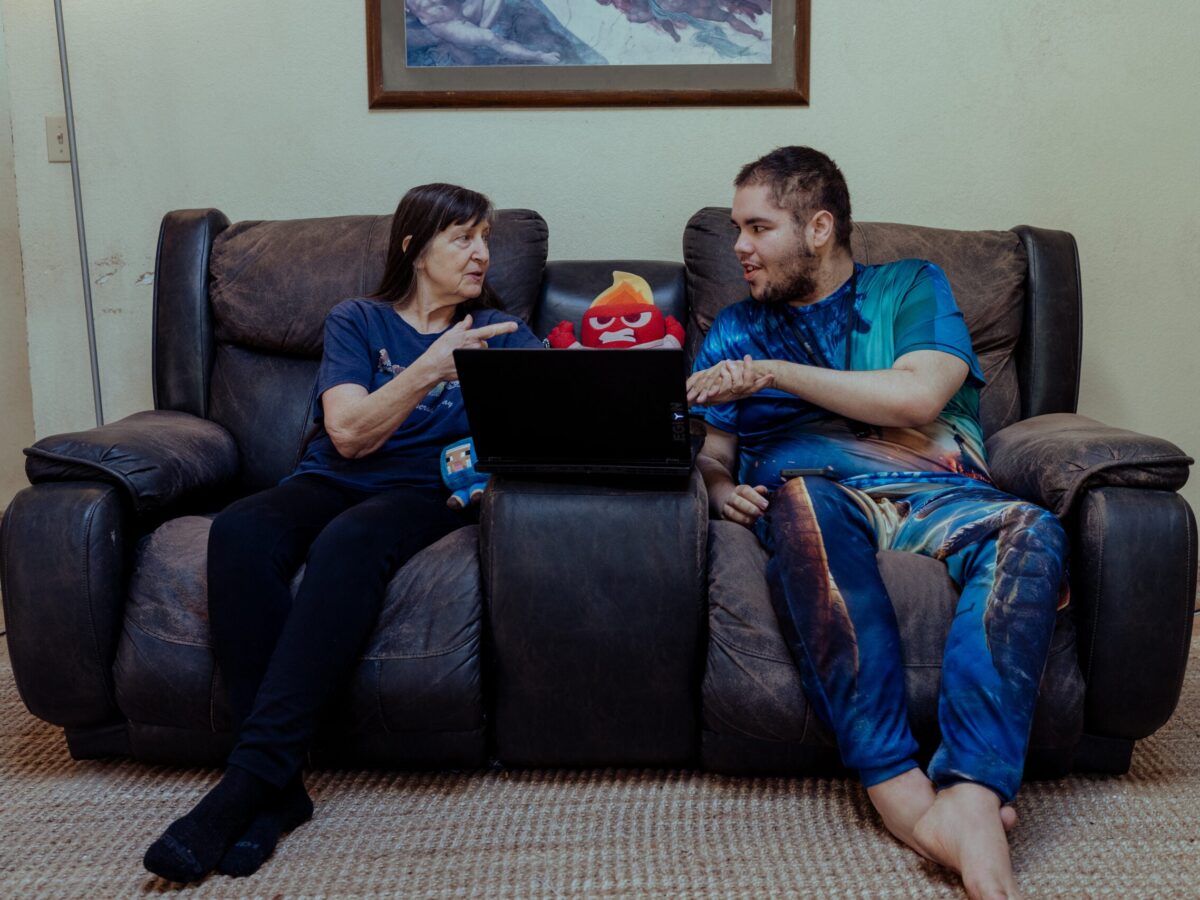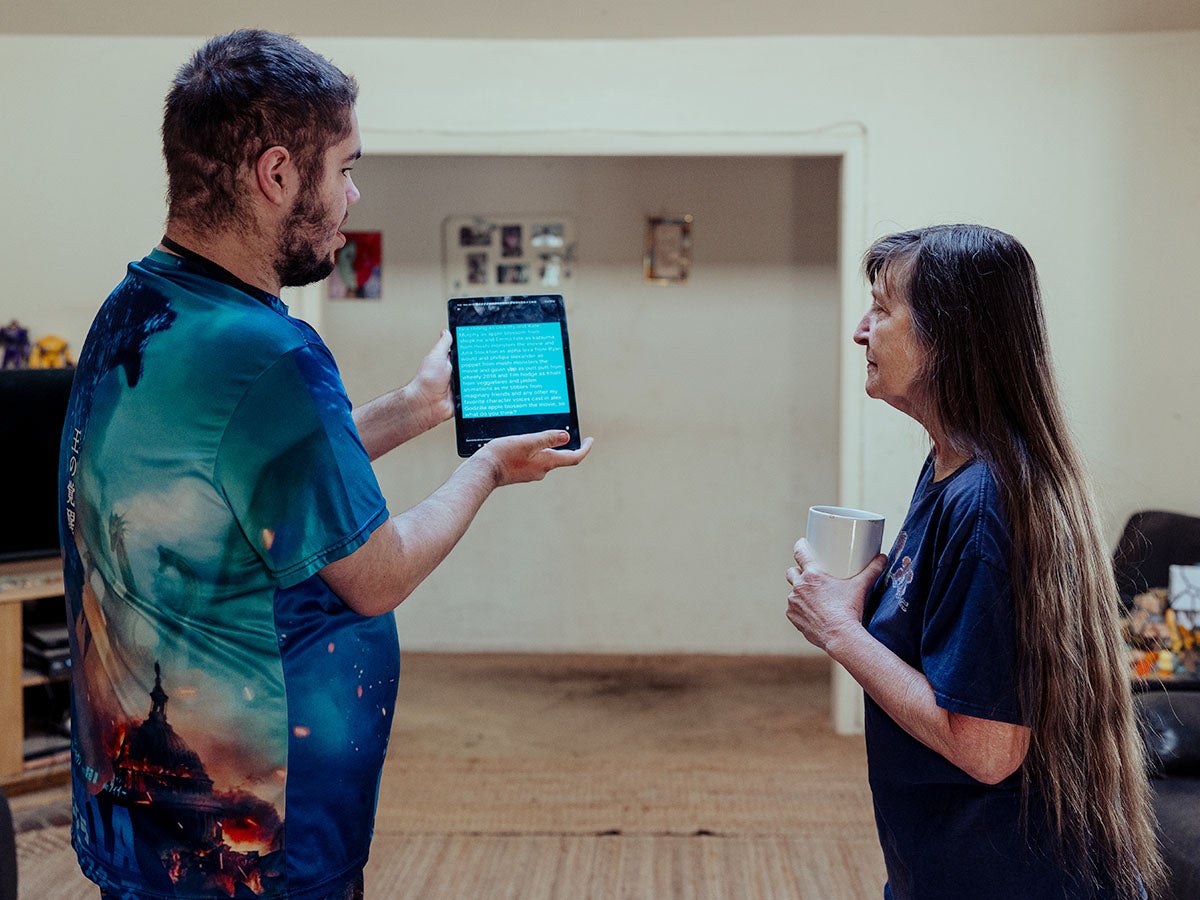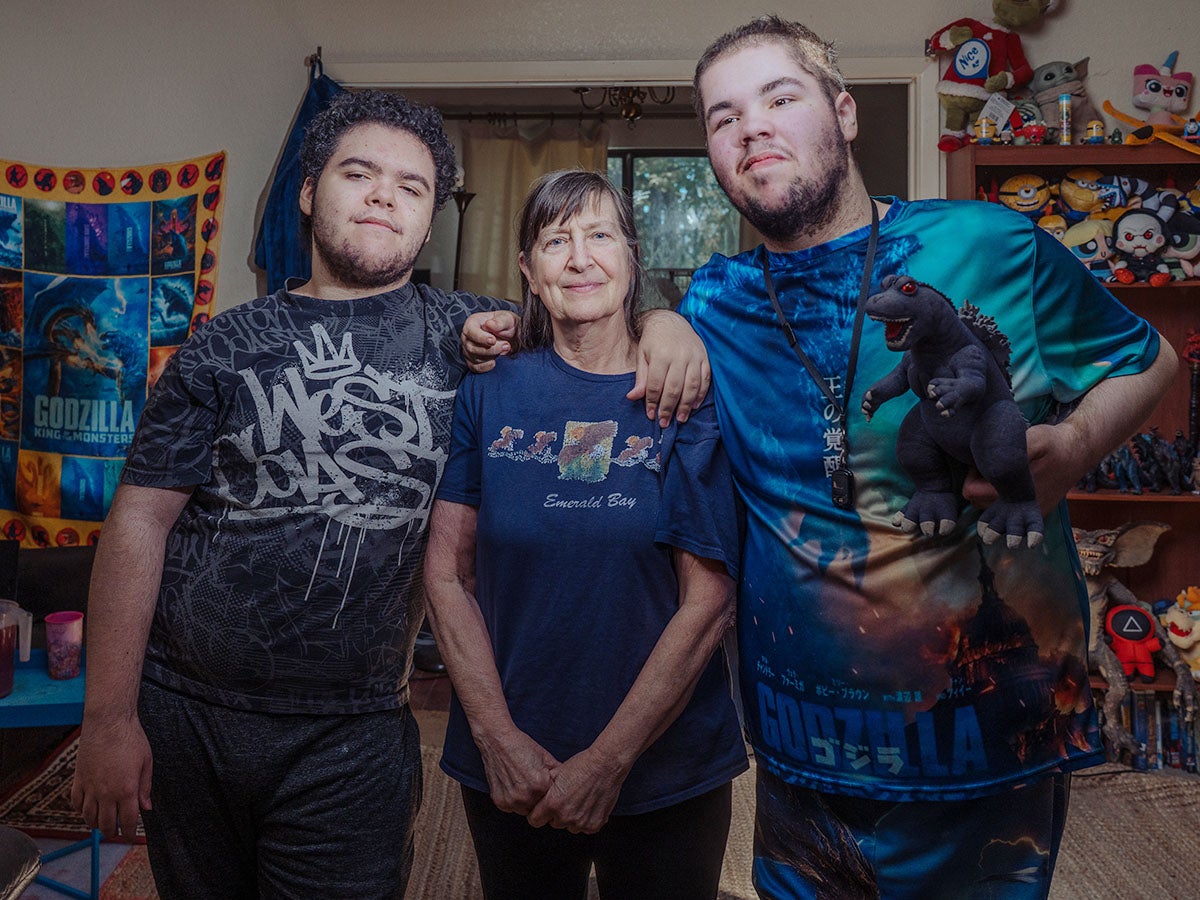|
Getting your Trinity Audio player ready…
|
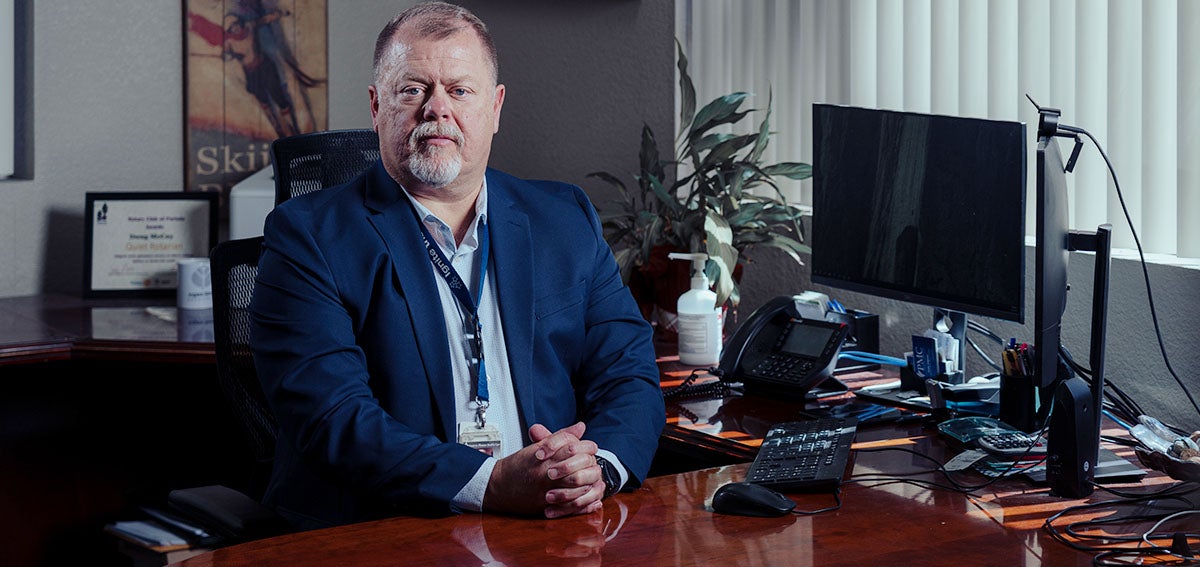
Stephanie Grier has reached an age when many people retire. Instead, the 65-year-old is trying to figure out how she might work two jobs if the health coverage she and her family rely on through Medi-Cal, California’s Medicaid program, were to be drastically cut.
Grier lives in Colfax, a small, Gold Rush-era town about an hour northeast of Sacramento. She currently works one full-time job: caring for her 16-year-old grandson, Alexander Villano, who has severe intellectual disabilities.
“He needs 24-hour supervision because he doesn’t understand what’s dangerous and what’s not dangerous, so he needs to be watched pretty much all the time,” Grier said. “He’s a sweetheart, but he’s 6 foot 1 and weighs [a lot]…He can on occasion get aggressive, and he’s not someone that’s easy to find care for.”
A Medi-Cal benefit called In-Home Supportive Services (IHSS) allows Grier to stay home and care for Alexander. She also looks after his 18-year-old brother Michael, who has autism. All three are enrolled in Medi-Cal, which covers each of their individual medical care needs. In addition, Grier is one of the 1.7 million Californians who have both Medicare and Medi-Cal. Medi-Cal steps in to pay for Medicare premiums and out-of-pocket costs for seniors with low incomes like Grier. Without Medi-Cal, she would likely not be able to afford her Medicare coverage. Without all this support, Grier said she would face an impossible situation: needing to find another job to cover household bills and medical expenses while still having to care for Alexander.
Fear of ‘Chaos’
“There would be chaos in the family,” she said.
That critical support now is on shaky ground. Budget cutters in Congress seek to reduce federal Medicaid spending by up to $880 billion over the next decade, triggering fears about the future among nearly 15 million Californians enrolled in Medi-Cal. While it’s not clear yet exactly how the cuts would be allocated, Medi-Cal enrollees and health care providers are concerned the reductions will cause widespread hardships for Californians with low incomes or disabilities, seniors in long-term care, and the overstretched health care system.
In Congressional District 3, a swath of eastern California that stretches 200 miles and spans 10 sparsely populated counties, about 1 in 4 people get health coverage through Medi-Cal. Medi-Cal spent a total of $2.25 billion on covered services and programs in the district in 2024. That spending supports over 10,000 people helped by the IHSS program, regional centers serving 7,000 people with developmental disabilities, and services for more than 1,500 foster youth.
Medi-Cal providers and recipients fear major cuts will damage working families, seniors, people with disabilities, and children in the program; financially destabilize the 14 hospitals and other providers who serve those receiving Medi-Cal; and disrupt the broader economy and community that benefits from the infusion of state and federal money that ripples across local businesses, households, and city and county treasuries.
“To cut back on Medicaid is self-destructive,” said Janice LeRoux, executive director of First 5 Placer, a community-based organization that works to improve systems serving families and young children in Placer County. “This is not a program that’s full of waste, fraud, and abuse. It’s one that’s really helping our neighbors, people who we see in the grocery store, people who take care of us.”
To Grier, having Medi-Cal means that, when Alexander broke his leg in elementary school, he was able to get a full-body cast, wheelchair, x-rays, and other care he needed. The program also paid for him to get therapy for his autism and specialized dental procedures, she said. And when Grier’s grandsons get sick or need preventive care, Medi-Cal covers their doctor’s visits.
‘People Will Remain Sicker for Longer’
Medi-Cal is also vital for Michelle Padilla, 49, of nearby Rocklin, who has a genetic disorder called 22q11.2 deletion syndrome, also known as DiGeorge syndrome or velocardiofacial syndrome. Padilla is immunocompromised and has a heart condition. Even though she carries commercial insurance through a job, she relies on Medi-Cal to help cover out-of-pocket costs related to her frequent doctor’s visits and surgeries.
Providers fear cuts to Medicaid would make it harder for people to get this kind of care. This could happen directly, if people are forced off Medi-Cal and left uninsured, or indirectly, if payments to Medi-Cal providers are reduced, which would make it harder for them to continue serving patients.
Jonathan Porteus, PhD, is CEO of WellSpace Health, a nonprofit community health system and the largest Medicaid provider in Placer County. He said his clinics would continue to see patients if funding for Medi-Cal were to be cut or people were to lose coverage, but they wouldn’t be able to hire as many medical staff. That would leave people waiting longer for care and force more patients into emergency rooms, he said.
“Essentially people will remain sicker for longer, and obviously we know that there’s a consequence,” he said. “You get sicker, you have chronic conditions develop, medications won’t be refilled or available…it’s a cascade.”
It’s not the scenario Porteus envisioned only a few months ago. WellSpace Health has been expanding services and locations and is about to open a new health center in Roseville, in Placer County. It’s supposed to include a new ob/gyn residency program to help meet a desperate need for prenatal and delivery services in the region, and the first dental clinic in the area that accepts children with Medi-Cal, so families won’t have to drive to Sacramento. With possible funding cuts looming, that now hangs in the balance, he said.
Meanwhile, Adam P. Dougherty, MD, MPH, chief of emergency medicine at Sutter Medical Center in Sacramento, is gearing up to see more patients in his emergency room who are driving in from rural areas east of the city because of untreated conditions or lack of Medi-Cal coverage. Already, it’s hard for many Medi-Cal patients in Congressional District 3 to get timely appointments with cardiologists, neurologists, and other specialists because the rural provider network is narrow and health care infrastructure expansion hasn’t kept pace with population growth, he said. If there are significant cuts to Medicaid, that will only get worse, he predicted.
“Cuts could potentially bring us back to a time where we’re seeing uninsured populations in the 15% to 20% range, which is just totally unacceptable from not only a health care delivery point of view but from a taxpayer point of view,” Dougherty said. “Paying for somebody on Medi-Cal is pennies on the dollar” compared to paying to treat uninsured people for unmanaged conditions in the hospital.
Any decrease in Medicaid funding is particularly threatening to the stability of hospitals in rural areas, whose patients tend to be people with low incomes. Hospitals are required by federal law to provide emergency care to everyone, regardless of a person’s ability to pay, so they would see higher costs if the number of uninsured people rises.
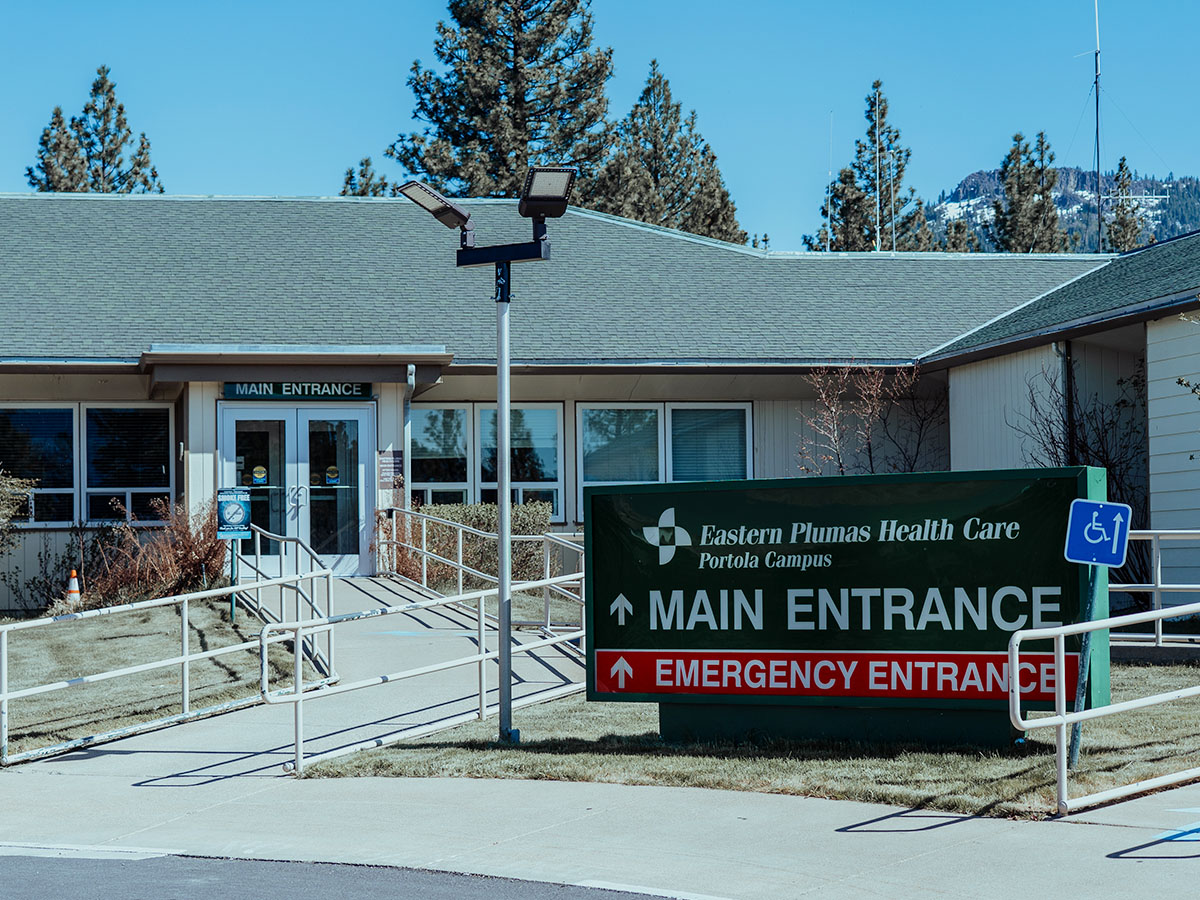
At Eastern Plumas Health Care, a critical access hospital system serving Eastern Plumas and Sierra Counties, about one-third of patients are on Medi-Cal, and 30% are over 65 years old. Without that hospital, area patients would need to drive 50 miles to Reno, Nevada, or 150 miles to Sacramento to get care — which is especially difficult during winter months in the mountains.
Technically, the Eastern Plumas hospital only breaks even on Medi-Cal patients because it receives supplemental Medicaid payments for rural hospitals, said CEO Doug McCoy. He’s worried those supplements could be drastically curtailed or ended altogether. That would require the hospital to cut services and halt medical technology upgrades, affecting all Eastern Plumas patients, not just those on Medi-Cal, he said.
“Reductions to the Medi-Cal reimbursement would be significant, and we have forecasted that that would clearly put us operating in a negative, based on some of the proposed potential reductions,” he said. “We’d be in an operational deficit every month.”
Medicaid cuts are expected to negatively impact the local economy as well. Medi-Cal currently accounts for $2.25 billion in spending in the vast Congressional District 3, according to the UC Berkeley Labor Center. Hospitals there rely on Medicaid for about one-quarter of their funding and in turn power the economy to the tune of 16,000 jobs supported by hospital spending, according to the California Hospital Association.
Partnership HealthPlan, a Medi-Cal managed care organization that covers about 1 in 5 people in the district, contracts with 1,227 specialists (over-represented in Sacramento’s northeastern suburbs in western Placer County), 305 primary care providers, 325 ancillary providers, and 27 hospitals and long-term care facilities, according to data provided by Partnership.
Hospitals at Risk
Sonja Bjork, CEO of Partnership HealthPlan, said the organization has invested significant resources into attracting providers to the region and retaining them through incentive programs. They’ve also built up a network of doulas to serve Medi-Cal patients expecting babies. She’s concerned that cuts would end these efforts and threaten the financial stability of hospitals and nursing facilities. She’s also worried it could lead to Medi-Cal enrollees not being able to find care because too few providers are available to serve them.
“Medi-Cal is so important in these rural communities for so many reasons, for their economic well-being, for people getting the basic health care they need, for specialty care, and even emergency care,” she said.
Back in Colfax, Grier has been weighing her options. So far, none of them is good. If she were to lose benefits for providing care to her grandson and had to find work outside the home, she could leave Alexander with his 18-year-old brother who has an attention deficit disorder, with an aunt who has schizophrenia, or in an institution. The last one would not only be devastating for Alexander and his family, it probably would be more expensive for taxpayers, she said.
“I don’t think they’ll actually be saving money,” Grier said about implications of the proposed cuts. “It would just be like taking money out of one pocket and putting it into another.”
Authors & Contributors

Claudia Boyd-Barrett
Independent journalist
Claudia Boyd-Barrett is a longtime journalist based in Southern California. She writes regularly about health and social inequities. Her stories have appeared in the Los Angeles Times, San Francisco Chronicle, San Diego Union-Tribune, and California Health Report, among others.
Boyd-Barrett is a two-time USC Annenberg Center for Health Journalism fellow and a former Inter American Press Association fellow.

Andri Tambunan
Documentary photographer and videographer
Andri Tambunan is a Sacramento-based documentary photographer and videographer. He specializes in photojournalism and long-term narrative. His documentary work focuses on social justice, health, environmental conservation, and identity, and he has a passion for using visual narrative to inform, engage, and effect social change.
As a multimedia journalist and storyteller, Tambunan has experience as a producer, visual creator, editor/curator, and project manager. He is proficient with image-editing software, studio lighting, video and audio capture, and many genres of photography.

